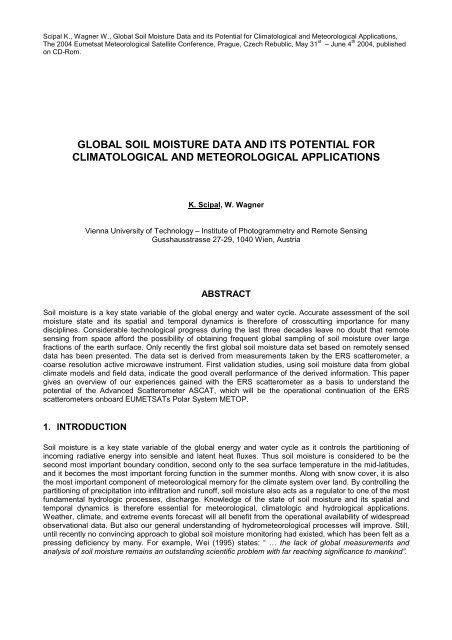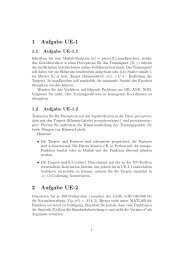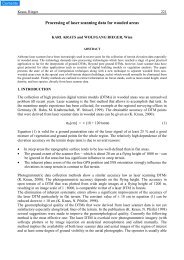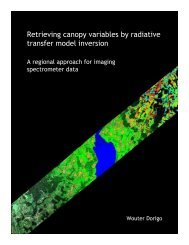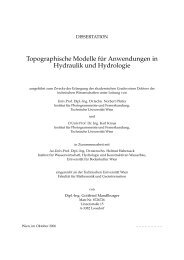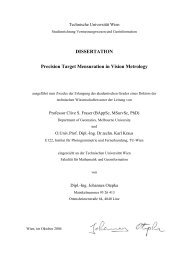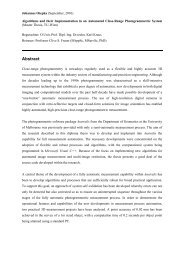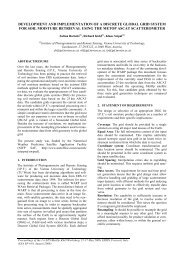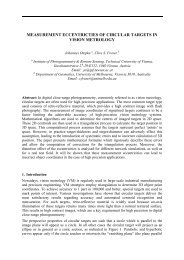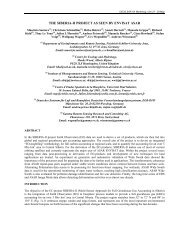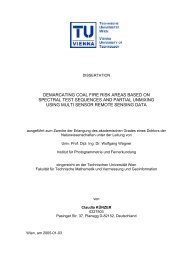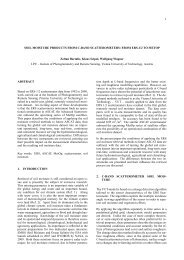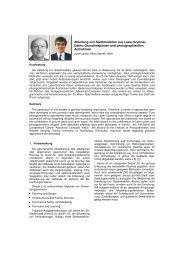global soil moisture data and its potential for climatological and ...
global soil moisture data and its potential for climatological and ...
global soil moisture data and its potential for climatological and ...
You also want an ePaper? Increase the reach of your titles
YUMPU automatically turns print PDFs into web optimized ePapers that Google loves.
Scipal K., Wagner W., Global Soil Moisture Data <strong>and</strong> <strong>its</strong> Potential <strong>for</strong> Climatological <strong>and</strong> Meteorological Applications,<br />
The 2004 Eumetsat Meteorological Satellite Conference, Prague, Czech Rebublic, May 31 st – June 4 th 2004, published<br />
on CD-Rom.<br />
GLOBAL SOIL MOISTURE DATA AND ITS POTENTIAL FOR<br />
CLIMATOLOGICAL AND METEOROLOGICAL APPLICATIONS<br />
K. Scipal, W. Wagner<br />
Vienna University of Technology – Institute of Photogrammetry <strong>and</strong> Remote Sensing<br />
Gusshausstrasse 27-29, 1040 Wien, Austria<br />
ABSTRACT<br />
Soil <strong>moisture</strong> is a key state variable of the <strong>global</strong> energy <strong>and</strong> water cycle. Accurate assessment of the <strong>soil</strong><br />
<strong>moisture</strong> state <strong>and</strong> <strong>its</strong> spatial <strong>and</strong> temporal dynamics is there<strong>for</strong>e of crosscutting importance <strong>for</strong> many<br />
disciplines. Considerable technological progress during the last three decades leave no doubt that remote<br />
sensing from space af<strong>for</strong>d the possibility of obtaining frequent <strong>global</strong> sampling of <strong>soil</strong> <strong>moisture</strong> over large<br />
fractions of the earth surface. Only recently the first <strong>global</strong> <strong>soil</strong> <strong>moisture</strong> <strong>data</strong> set based on remotely sensed<br />
<strong>data</strong> has been presented. The <strong>data</strong> set is derived from measurements taken by the ERS scatterometer, a<br />
coarse resolution active microwave instrument. First validation studies, using <strong>soil</strong> <strong>moisture</strong> <strong>data</strong> from <strong>global</strong><br />
climate models <strong>and</strong> field <strong>data</strong>, indicate the good overall per<strong>for</strong>mance of the derived in<strong>for</strong>mation. This paper<br />
gives an overview of our experiences gained with the ERS scatterometer as a basis to underst<strong>and</strong> the<br />
<strong>potential</strong> of the Advanced Scatterometer ASCAT, which will be the operational continuation of the ERS<br />
scatterometers onboard EUMETSATs Polar System METOP.<br />
1. INTRODUCTION<br />
Soil <strong>moisture</strong> is a key state variable of the <strong>global</strong> energy <strong>and</strong> water cycle as it controls the partitioning of<br />
incoming radiative energy into sensible <strong>and</strong> latent heat fluxes. Thus <strong>soil</strong> <strong>moisture</strong> is considered to be the<br />
second most important boundary condition, second only to the sea surface temperature in the mid-latitudes,<br />
<strong>and</strong> it becomes the most important <strong>for</strong>cing function in the summer months. Along with snow cover, it is also<br />
the most important component of meteorological memory <strong>for</strong> the climate system over l<strong>and</strong>. By controlling the<br />
partitioning of precipitation into infiltration <strong>and</strong> runoff, <strong>soil</strong> <strong>moisture</strong> also acts as a regulator to one of the most<br />
fundamental hydrologic processes, discharge. Knowledge of the state of <strong>soil</strong> <strong>moisture</strong> <strong>and</strong> <strong>its</strong> spatial <strong>and</strong><br />
temporal dynamics is there<strong>for</strong>e essential <strong>for</strong> meteorological, climatologic <strong>and</strong> hydrological applications.<br />
Weather, climate, <strong>and</strong> extreme events <strong>for</strong>ecast will all benefit from the operational availability of widespread<br />
observational <strong>data</strong>. But also our general underst<strong>and</strong>ing of hydrometeorological processes will improve. Still,<br />
until recently no convincing approach to <strong>global</strong> <strong>soil</strong> <strong>moisture</strong> monitoring had existed, which has been felt as a<br />
pressing deficiency by many. For example, Wei (1995) states: “ … the lack of <strong>global</strong> measurements <strong>and</strong><br />
analysis of <strong>soil</strong> <strong>moisture</strong> remains an outst<strong>and</strong>ing scientific problem with far reaching significance to mankind”.
Principally, there are many well-established methodologies to measure <strong>soil</strong> <strong>moisture</strong> on ground. However,<br />
area representative precise in-situ measurements are in general expensive <strong>and</strong> tedious to collect. There<strong>for</strong>e,<br />
only a few large scale measurement networks providing widespread in<strong>for</strong>mation exist (Robock, 2000). An<br />
alternative to ground based measurement networks are remote sensing techniques. Among the various<br />
techniques, especially microwave remote sensing (active <strong>and</strong> passive) provides the opportunity to collect truly<br />
quantitative <strong>soil</strong> <strong>moisture</strong> in<strong>for</strong>mation. Microwaves offer relatively direct means of assessing <strong>soil</strong> <strong>moisture</strong>.<br />
They exploit, like many in-situ observation techniques, the strong relationship between the <strong>moisture</strong> content<br />
<strong>and</strong> dielectric constant of <strong>soil</strong>. Technological <strong>and</strong> methodological progress of recent years have resulted in<br />
the approval of dedicated <strong>soil</strong> <strong>moisture</strong> missions. ESAs Soil Moisture <strong>and</strong> Ocean Salinity Mission (SMOS)<br />
<strong>and</strong> NASAs HYDROS are expected to provide a flow of high quality coarse resolution <strong>soil</strong> <strong>moisture</strong> <strong>data</strong>.<br />
Apart from these dedicated hydrometeorological missions, a sensor initially designed <strong>for</strong> ocean applications,<br />
the ERS scatterometer, has attracted the attention of the scientific community. Based on ERS scatterometer<br />
<strong>data</strong> the first <strong>global</strong> remotely sensed <strong>soil</strong> <strong>moisture</strong> <strong>data</strong> set has been derived <strong>and</strong> was found to be of<br />
reasonable accuracy. The ERS scatterometer mission will find continuation on EUMETSATs Polar System<br />
METOP, carrying the Advanced Scatterometer ASCAT. The system presents one of the few operational<br />
systems with security of long-term tenure <strong>and</strong> funding. This paper will there<strong>for</strong>e give an overview of the<br />
<strong>potential</strong> of the Advanced Scatterometer <strong>for</strong> <strong>global</strong> <strong>soil</strong> <strong>moisture</strong> retrieval.<br />
2. SOIL MOISTURE FROM SCATTEROMETERS<br />
Scatterometers are active microwave sensors (radars) designed to retrieve wind speed <strong>and</strong> direction over the<br />
oceans. However, it is increasingly acknowledged that the unique technical characteristics of the sensors are<br />
also beneficial <strong>for</strong> monitoring highly dynamic geophysical processes over l<strong>and</strong>. The ERS scatterometers are<br />
radars operated in C-b<strong>and</strong>. They have been flown on the European Remote Sensing Satellites ERS-1 <strong>and</strong><br />
ERS-2 operated by the European Space Agency. The instrument has been providing <strong>global</strong> coverage since<br />
the launch of ERS-1 in 1991, with a revisit time of about 3-4 days, acquiring imagery independent of cloud<br />
cover <strong>and</strong> of the sun as source of illumination. The fundamental reason why any microwave technique, <strong>and</strong> in<br />
particular the ERS <strong>and</strong> METOP scatterometers, offer the opportunity to measure <strong>soil</strong> <strong>moisture</strong> in a relatively<br />
direct manner is the high sensitivity of microwaves to the water content in the <strong>soil</strong> surface layer due to the<br />
pronounced increase in the <strong>soil</strong> dielectric constant with increasing water content. This is specifically the case<br />
in the low frequency region (1-10 GHz). However, scattering from l<strong>and</strong> surfaces also depends on other<br />
factors. The benefit of using the ERS <strong>and</strong> METOP scatterometers <strong>for</strong> <strong>soil</strong> <strong>moisture</strong> retrieval is their unique<br />
sensor design, which enables direct accounting <strong>for</strong> the confounding effects of surface roughness, vegetation<br />
<strong>and</strong> dielectric properties. Following are the outst<strong>and</strong>ing sensor characteristics: 1) The multi-incidence angle<br />
viewing capability which allows separating vegetation <strong>and</strong> <strong>soil</strong> <strong>moisture</strong> effects which both influence the<br />
measured backscatter coefficient, 2) The high temporal sampling rate which allows monitoring of highly<br />
dynamic processes such as the <strong>soil</strong> <strong>moisture</strong> process 3) The excellent radiometric accuracy which results in<br />
a low noise level <strong>and</strong> allows analysing multi annual time series.<br />
For retrieval of <strong>soil</strong> <strong>moisture</strong> from ERS scatterometer <strong>data</strong>, a change detection algorithm tailored to the<br />
sensor characteristics has been developed by Wagner et al. (1999). The algorithm explo<strong>its</strong>, similar to the<br />
algorithm <strong>for</strong>eseen <strong>for</strong> SMOS, the multiple viewing capabilities of the sensor in order to separate <strong>soil</strong> <strong>moisture</strong><br />
<strong>and</strong> vegetation effects. It also allows accounting <strong>for</strong> the effects of heterogeneous l<strong>and</strong> cover <strong>and</strong> surface<br />
roughness. Unlike more complex theoretical or semi-empirical approaches often preferred <strong>for</strong> retrieval<br />
purposes, change detection is attractive <strong>for</strong> <strong>global</strong> applications because applied to radar backscatter time<br />
series it represents an indirect way of accounting <strong>for</strong> surface roughness effects. Particularly at the spatial<br />
scale of scatterometers (tens of kilometres), surface roughness changes due to farming activities or other<br />
effects can be assumed to have negligible effects on the scatterometer recorded backscatter time series.<br />
Also, change detection applied to ERS scatterometer <strong>data</strong> accounts <strong>for</strong> heterogeneous l<strong>and</strong> cover since<br />
many l<strong>and</strong> cover classes such as <strong>for</strong>ests, dense shrubs, urban areas <strong>and</strong> small inl<strong>and</strong> water bodies are<br />
characterised by relatively stable C-b<strong>and</strong> backscatter values <strong>and</strong> hence do not need to be separately<br />
modelled. On the other h<strong>and</strong>, the model must consider vegetation growth <strong>and</strong> decay over grassl<strong>and</strong> <strong>and</strong><br />
agricultural regions since this may cause backscatter to change by several decibels. The increase in biomass<br />
may increase or decrease backscatter depending on the incidence angle <strong>and</strong> <strong>soil</strong> <strong>moisture</strong> conditions. An<br />
increase in backscatter is typically encountered at high incidence angles <strong>and</strong> dry <strong>soil</strong> conditions, whereas a<br />
decrease at low incidence angles <strong>and</strong> wet <strong>soil</strong> <strong>moisture</strong> conditions. Since this effect is captured by the multiincidence<br />
observations of the ERS scatterometer it becomes possible to quantitatively correct <strong>for</strong> the effects<br />
of vegetation phenology. As a result, time series of the top<strong>soil</strong> <strong>moisture</strong> content are obtained.
3. FROM ERS TO METOP<br />
The successor of the ERS Scatterometer will be the Advanced Scatterometer which will be flown on a series<br />
of three METOP satellites. METOP is a joint project of the European Space Agency <strong>and</strong> the European<br />
Organisation <strong>for</strong> the Exploitation of Meteorological Satellites. The design of ASCAT is based on the<br />
successful concept of the ERS scatterometers. Like <strong>its</strong> predecessors, ASCAT will use fan-beam antennas<br />
operating in C-b<strong>and</strong>. However the experience acquired with nearly one decade of operations of the ERS<br />
scatterometers <strong>and</strong> technological advances have lead to significant improvements.<br />
The most prominent improvement of ASCAT will be an increased spatial <strong>and</strong> temporal resolution. Although it<br />
is planned that the initial <strong>data</strong> product of ASCAT will be made available at 50 km resolution (like <strong>for</strong> the ERS<br />
scatterometers) EUMETSAT plans to distribute <strong>data</strong> also in a scientific <strong>for</strong>mat at 25 km resolution. To<br />
improve the temporal resolution ASCAT will use six antennas which cover two swaths to the left <strong>and</strong> right of<br />
the satellite track instead of three antennas with only one swath which was the case <strong>for</strong> ERS. Additionally<br />
ASCAT will provide continuous <strong>data</strong> acquisition without sharing operation time with other sensors. As a result,<br />
the instrument acquires <strong>data</strong> from 82 % of the earth surface within one day, which will significantly increase<br />
the temporal sampling rate compared to the ERS Scatterometer. It can also be expected that improved<br />
instrument design will result in higher stability <strong>and</strong> reliability of the <strong>data</strong>. Finally, EUMETSATs Polar System<br />
satellites, which will carry the ASCAT sensor, are planned as an operational system with security of long-term<br />
tenure <strong>and</strong> funding starting <strong>its</strong> operation with the METOP-1 satellite in 2005. Currently a series of three<br />
satellites is planned <strong>for</strong> a nominal lifetime of 14 years. Given the similarity between the ERS scatterometers<br />
<strong>and</strong> the ASCAT scatterometers, the methods developed <strong>for</strong> the ERS scatterometer should be directly<br />
applicable <strong>for</strong> ASCAT after an initial test phase. It can there<strong>for</strong>e be expected that a consistent <strong>data</strong> set of the<br />
<strong>soil</strong> hydrology starting with 1991 will be available to the scientific community.<br />
4. SOIL MOISTURE PRODUCTS<br />
Currently two <strong>soil</strong> <strong>moisture</strong> products are derived from ERS scatterometer <strong>data</strong>, surface <strong>soil</strong> <strong>moisture</strong> <strong>and</strong><br />
profile <strong>soil</strong> <strong>moisture</strong>. The surface <strong>moisture</strong> is a relative measure of <strong>soil</strong> <strong>moisture</strong> in the first centimetre of the<br />
<strong>soil</strong> ranging between 0 <strong>and</strong> 100, representing the degree of saturation. Soil <strong>moisture</strong> can only be retrieved<br />
under snow-free conditions. Over dense tropical <strong>for</strong>est retrieval is not possible which affects about 6.5 % of<br />
the l<strong>and</strong> surface area. Also in s<strong>and</strong> desert areas spurious effects are observed in the backscattered signal.<br />
These are related to azimuthal viewing effects which are currently not correctly treated in the retrieval <strong>and</strong><br />
there<strong>for</strong>e masked. The other product is the profile <strong>soil</strong> <strong>moisture</strong> or Soil Water Index (SWI). The SWI is a<br />
relative measure of the <strong>soil</strong> <strong>moisture</strong> content of the 1 meter <strong>soil</strong> layer ranging between 0 <strong>and</strong> 100 (Figure 1).<br />
In order to retrieve <strong>soil</strong> <strong>moisture</strong> measurements over greater depths (up to about one meter) a two-layer<br />
water balance model, which only considers the exchange of <strong>soil</strong> water between the topmost remotely sensed<br />
layer <strong>and</strong> the “reservoir” below, was used to establish a relationship between the top<strong>soil</strong> series <strong>and</strong> the profile<br />
<strong>soil</strong> <strong>moisture</strong> content (Wagner et al., 1999). The water content in the <strong>soil</strong> profile is estimated by convoluting<br />
the surface <strong>soil</strong> <strong>moisture</strong> series with an exponential filter. The derived profile <strong>soil</strong> <strong>moisture</strong> time series has a<br />
spectrum similar to that of a red-noise process, which is often used to describe the statistical properties of<br />
modelled <strong>and</strong> in-situ <strong>soil</strong> <strong>moisture</strong> <strong>data</strong>. If <strong>soil</strong> hydrologic properties are known (wilting level, field capacity <strong>and</strong><br />
total water holding capacity) the SWI can be related to the volumetric <strong>soil</strong> <strong>moisture</strong> content.<br />
5. NEAR REAL TIME CAPABILITIES<br />
Scatterometers are designed to continuously record <strong>and</strong> transmit <strong>data</strong> to the ground stations. Due to the low<br />
<strong>data</strong> bit rate, the processing load is moderate <strong>and</strong> an operational application of the proposed technique is<br />
realistic. A prototype near real time operator <strong>for</strong> <strong>soil</strong> <strong>moisture</strong> retrieval has already been tested <strong>and</strong><br />
implemented <strong>for</strong> the ERS scatterometer to monitor <strong>soil</strong> <strong>moisture</strong> conditions over Africa <strong>and</strong> Central Asia <strong>for</strong><br />
the Food <strong>and</strong> Agriculture Organisation of the United Nations. The system has been operated <strong>for</strong> nearly six<br />
month <strong>and</strong> delivered <strong>soil</strong> <strong>moisture</strong> <strong>data</strong> on a weekly basis. Un<strong>for</strong>tunately, the system had to be discontinued<br />
after the ERS scatterometer mission has temporarily been stopped due to technical problems.<br />
Given the very similar technical characteristics of the ERS <strong>and</strong> the Advanced scatterometer it is possible to<br />
use the existing algorithms to deliver operational 25 km <strong>soil</strong> <strong>moisture</strong> products in quasi-real time (2-3 hours<br />
after reception) with an expected accuracy of about 0.05 m 3 m -3 . Every day to every other day the Advanced<br />
scatterometer could deliver an update of the status of the regional <strong>soil</strong> <strong>moisture</strong> conditions within a few hours
after <strong>data</strong> reception. Technically near real time processing can be started immediately after the Advanced<br />
scatterometer is in an operational phase. The required <strong>data</strong>sets <strong>for</strong> retrieving <strong>soil</strong> <strong>moisture</strong> from ASCAT <strong>data</strong><br />
can be set up using historic ERS scatterometer measurements (<strong>for</strong> reliable <strong>soil</strong> <strong>moisture</strong> retrieval knowledge<br />
of backscattering characteristics <strong>for</strong> each point of the earth surface is required which is extracted from long<br />
time series spanning several years of <strong>data</strong>). Given the similarities between the sensors, using the historic<br />
backscatter <strong>data</strong> should not constrain the retrieval of <strong>soil</strong> <strong>moisture</strong> from ASCAT <strong>data</strong>. An optimisation of the<br />
retrieval will be achieved by frequent reanalysis of the historic backscatter knowledgebase incorporating <strong>data</strong><br />
from ASCAT.<br />
Figure 1. Mean monthly Soil Water Index derived from ERS scatterometer <strong>data</strong> <strong>for</strong> January, April, July, <strong>and</strong><br />
October. Brown colour tones indicate dry conditions, blue colour tones indicate wet conditions.<br />
6. ACCURACY<br />
To assess the quality of scatterometer derived <strong>soil</strong> <strong>moisture</strong>, <strong>data</strong> has been compared extensively with <strong>soil</strong><br />
<strong>moisture</strong> in<strong>for</strong>mation from various sources. Wagner et al. (2003) compared scatterometer derived monthly<br />
<strong>soil</strong> <strong>moisture</strong> estimates with <strong>global</strong> gridded precipitation <strong>data</strong> <strong>and</strong> <strong>global</strong> modelled <strong>soil</strong> <strong>moisture</strong> of the 0-50<br />
cm layer. The study showed that there is reasonable agreement between the different <strong>data</strong>sets especially<br />
under tropical <strong>and</strong> temperate climates. Only in extreme climates such as deserts <strong>and</strong> the arctic, spurious<br />
effects have been observed. Given, that the accuracy of the gridded precipitation <strong>and</strong> the modelled <strong>soil</strong><br />
<strong>moisture</strong> is not known it is not possible to draw any quantitative conclusions. Considering that the <strong>data</strong>sets<br />
are independent it is however reasonable to assume that a high agreement indicate regions of good <strong>data</strong><br />
quality <strong>and</strong> that in such a case upper lim<strong>its</strong> of the accuracy of the scatterometer derived <strong>soil</strong> <strong>moisture</strong> can be<br />
inferred. This upper limit has been determined to be in the range of 0.03-0.07 m 3 m -3 . The comparison with<br />
gridded precipitation also showed that reasonable agreement can only be achieved over areas with high<br />
station density. This observation led to the impression that remotely sensed <strong>soil</strong> <strong>moisture</strong>, being independent<br />
of the availability of ground <strong>data</strong>, can improve our capabilities to monitor extreme <strong>soil</strong> <strong>moisture</strong> conditions<br />
especially in regions with sparse station networks. Dirnmeyer et al. (2003) have compared the scatterometer<br />
<strong>data</strong> set with seven other <strong>global</strong> wetness products, three produced by l<strong>and</strong> surface model calculations, three<br />
from coupled l<strong>and</strong> atmosphere reanalysis, <strong>and</strong> the NOAA/NESDIS <strong>data</strong> set derived from SSM/I radiometer<br />
<strong>data</strong>. They found that, while the SSM/I <strong>data</strong> have clearly a different character than all of the other <strong>data</strong> sets,<br />
the ERS scatterometer <strong>data</strong> revealed many similarities with the modeled wetness products. In another study<br />
Campling <strong>and</strong> De Belder (2003) found that there is a significant correlation between the ERS <strong>soil</strong> <strong>moisture</strong><br />
<strong>data</strong> <strong>and</strong> the ERA-40 reanalysis <strong>data</strong> set produced by the European Centre <strong>for</strong> Medium Range Weather
Forecasts (ECMWF) <strong>for</strong> the major cultivated regions of the globe. On the other h<strong>and</strong>, low correlations were<br />
observed over high-latitude regions <strong>and</strong> desert areas. Over some test sites it was observed that ERA-40<br />
rainfall deviated strongly from observed rainfall, in which case ERA-40 modelled <strong>soil</strong> <strong>moisture</strong> <strong>data</strong> appeared<br />
to be unrealistic.<br />
A quantitative assessment of the quality of the <strong>soil</strong> <strong>moisture</strong> product was carried out by Scipal (2002) using<br />
over 45000 <strong>soil</strong> <strong>moisture</strong> measurements from 372 stations worldwide. Samples were taken at<br />
agrometeorological large-scale measurement networks located in Russia, Ukraine, China, Mongolia <strong>and</strong> the<br />
US, covering a wide range of <strong>soil</strong> types <strong>and</strong> climatic regions. For Ukraine, Russia <strong>and</strong> Illinois <strong>soil</strong> <strong>moisture</strong><br />
samples from a depth of 1m were compared. In India <strong>and</strong> China, <strong>soil</strong> <strong>moisture</strong> samples from a depth of 50<br />
<strong>and</strong> 60 cm respectively were used, as samples of deeper layers were not available. Statistical analysis<br />
indicated an accuracy of scatterometer derived <strong>soil</strong> <strong>moisture</strong> <strong>for</strong> the 1m layer between 0.049 m 3 m -3 <strong>and</strong> 0.084<br />
m 3 m -3 depending on the measurement network. The average accuracy was determined to be 0.054 m 3 m -3 .<br />
Even better values have been determined <strong>for</strong> <strong>soil</strong> <strong>moisture</strong> anomalies with an average accuracy of 0.032<br />
m 3 m -3 . A more detailed study, was carried out by Ceballos et al. (2003) who compared scatterometer derived<br />
<strong>soil</strong> <strong>moisture</strong> to field observations from the REMEDHUS network. All stations of the REMEDHUS network are<br />
within one scatterometer pixel there<strong>for</strong>e allowing a more detailed assessment of <strong>soil</strong> <strong>moisture</strong> conditions of<br />
the covered region. For the comparison, <strong>data</strong> from twenty stations were averaged. The resulting time series<br />
compared well with scatterometer derived <strong>soil</strong> <strong>moisture</strong>. The coefficient of estimation R 2 <strong>for</strong> the average <strong>soil</strong><br />
<strong>moisture</strong> profile (0-100 cm) reached a value of 0.74 <strong>and</strong> the mean square error (RMS error) was 2.2 vol.%.<br />
7. OTHER SOIL MOISTURE MISSIONS<br />
The insistent request <strong>for</strong> <strong>soil</strong> <strong>moisture</strong> <strong>data</strong> coupled with technological <strong>and</strong> methodological progress of recent<br />
years have resulted in the approval of dedicated <strong>soil</strong> <strong>moisture</strong> missions. In the next couple of years several<br />
satellite missions, both operational <strong>and</strong> experimental will be available to observe <strong>global</strong> hydrometeorological<br />
processes (Figure 2). Two missions which have received much attention in recent years are the experimental<br />
satellite missions SMOS <strong>and</strong> HYDROS. SMOS is ESA’s second Earth Explorer Opportunity Mission <strong>and</strong> will<br />
make passive measurements at a spatial resolution of about 40 km. HYDROS is a NASA Earth System<br />
Science Pathfinder mission <strong>and</strong> will combine a radiometer (40 km) <strong>and</strong> a radar (3 <strong>and</strong> 10 km). Foreseen<br />
launch dates are 2007 <strong>and</strong> 2010 respectively. As a lower microwave frequency is beneficial <strong>for</strong> <strong>soil</strong> <strong>moisture</strong><br />
retrieval (longer wavelengths are more able to penetrate vegetation), both missions are operated in L-b<strong>and</strong>.<br />
These two missions will per<strong>for</strong>m first-of-a-kind exploratory measurements <strong>and</strong> aim to measure <strong>soil</strong> <strong>moisture</strong><br />
with an accuracy of 0.04 m 3 m -3 . Besides these two dedicated <strong>soil</strong> <strong>moisture</strong> missions there are other<br />
operational radiometer systems which have been found capable of <strong>soil</strong> <strong>moisture</strong> retrieval.<br />
Among the latest generation of radiometers is the Advanced Microwave Scanning Radiometers, AMSR-E,<br />
which was launched in 2002 onboard the AQUA satellite. This instrument receives at 6 frequencies ranging<br />
from 6.9 GHz (C-B<strong>and</strong>) to 89.0 GHz, with a spatial resolution ranging between 56 km (6.9 GHz) <strong>and</strong> 5.4 km<br />
(89 GHz). One general problem with the AMSR <strong>and</strong> similar radiometers planned <strong>for</strong> the future such as the<br />
Conical-scanning Microwave Imager/Sounder (CMIS), which have their lowest frequency channel in C-b<strong>and</strong>,<br />
is that within this frequency b<strong>and</strong> there is no international allocation <strong>for</strong> the passive Earth Exploration Satellite<br />
Service (EESS). There<strong>for</strong>e, retrieval from C-b<strong>and</strong> brightness temperature <strong>data</strong> may be hampered by Radio<br />
Frequency Interference (RFI) over populated areas. One advantage of radiometers compared to radars is<br />
that the retrieval from passive <strong>data</strong> appears to be less confounded by surface roughness effects than from<br />
active <strong>data</strong>. However, no <strong>global</strong>ly consistent <strong>soil</strong> <strong>moisture</strong> <strong>data</strong> set has yet been derived from spaceborne<br />
radiometers. There<strong>for</strong>e, the achievable accuracy <strong>and</strong> <strong>potential</strong> problems can at the present not be thoroughly<br />
assessed.
Figure 2: Suitability of satellite missions <strong>for</strong> <strong>soil</strong> <strong>moisture</strong> retrieval.<br />
8. BENEFITS<br />
Soil <strong>moisture</strong> is regarded to be a key state variable of the <strong>global</strong> energy <strong>and</strong> water cycle. It is commonly<br />
recognised that, with the operational availability of widespread observational <strong>data</strong>, our underst<strong>and</strong>ing of<br />
hydrometeorological processes will improve as well as <strong>for</strong>casting of weather, climate, <strong>and</strong> extreme events.<br />
The future generation of satellite systems will <strong>for</strong> the first time make <strong>global</strong> operational <strong>soil</strong> <strong>moisture</strong><br />
observations a reality. The METOP satellite series of EUMETSATs Polar System with <strong>its</strong> Advanced<br />
Scatterometer onboard will share an outst<strong>and</strong>ing role together with other systems. METOP will be the first<br />
operational satellite system with a proven <strong>and</strong> tested capability to retrieve <strong>soil</strong> <strong>moisture</strong> in<strong>for</strong>mation. Together<br />
with <strong>its</strong> predecessors, the ERS scatterometers, it will be possible to obtain continuous <strong>soil</strong> <strong>moisture</strong><br />
in<strong>for</strong>mation starting with 1991, with an estimated accuracy of 0.06 m 3 m -3 . The system will also allow near real<br />
time processing of <strong>data</strong>. Such nearly every second day a <strong>global</strong> assessment of the <strong>soil</strong> <strong>moisture</strong> state will be<br />
available. The operational character will also have implications on the scientific <strong>and</strong> commercial exploitation<br />
of the <strong>data</strong>. Given that <strong>soil</strong> <strong>moisture</strong> plays a crucial role in various disciplines, a <strong>potential</strong>ly large user<br />
community will be attracted. For example making experimental <strong>global</strong> <strong>soil</strong> <strong>moisture</strong> <strong>data</strong>, derived from the<br />
ERS scatterometer sensor, available on the internet has attracted the interest <strong>for</strong>m nearly 60 research<br />
institutions with a background in climatology, hydrology, agronomy <strong>and</strong> ecology.<br />
9. REFERENCES<br />
CAMPLING, P., DE BELDER J. (2003) CLIMSCAT Qualification Report, European Space Agency, Data User<br />
Programme 2001, http://dup.esrin.esa.it/projects/summaryp40.asp.<br />
CEBALLOS A., SCIPAL K., WAGNER W., MARTÍNEZ-FERNÁNDEZ J. (2004) Validation of ERS<br />
Scatterometer-Derived Soil Moisture Data in the Central Part of the Duero Basin, Spain, Journal of<br />
Hydrologic Processes, in press.<br />
DIRNMEYER, P. A., GUO Z., GAO X. (2003) Validation <strong>and</strong> <strong>for</strong>ecast applicability of multi-year <strong>global</strong> <strong>soil</strong><br />
wetness products, COLA Technical Report, Center <strong>for</strong> Ocean-L<strong>and</strong>-Atmosphere Studies,<br />
http://www.iges.org/, 12. December 2003.<br />
ROBOCK A., VINNIKOV K. Y., SRINIVASAN G., ENTIN J. K., HOLLINGER S. E., SPERANSKAYA N. A.,<br />
LIU S., NAMKHAI A. (2000) The Global Soil Moisture Data Bank. Bull. Amer. Meteorol. Soc., vol 81, pp.<br />
1281-1299.<br />
SCIPAL K. (2002) Global <strong>soil</strong> <strong>moisture</strong> retrieval from ERS scatterometer <strong>data</strong>, Dissertation, Vienna University<br />
of Technology.<br />
WAGNER W., LEMOINE G., ROTT H. (1999) A method <strong>for</strong> estimating <strong>soil</strong> <strong>moisture</strong> from ERS Scatterometer<br />
<strong>and</strong> <strong>soil</strong> <strong>data</strong>. Remote Sensing of Enviroment, vol 70, pp. 191-207.
WAGNER, W., SCIPAL K., PATHE C., GERTEN D., LUCHT W., RUDOLF B. (2003) Evaluation of the<br />
agreement between the first <strong>global</strong> remotely sensed <strong>soil</strong> <strong>moisture</strong> <strong>data</strong> with model <strong>and</strong> precipitation <strong>data</strong>,<br />
Journal of Geophysical Research – Atmospheres, Vol. 108, No. D19, 4611, doi: 10.1029/2003JD003663.<br />
WEI, M.-Y., Ed., (1995) Soil Moisture: Report of a Workshop Held in Tiburon, Cali<strong>for</strong>nia, 25-27 January 1994,<br />
NASA Conference Publication 3319, 80 pp.


